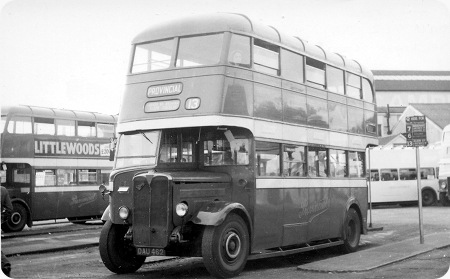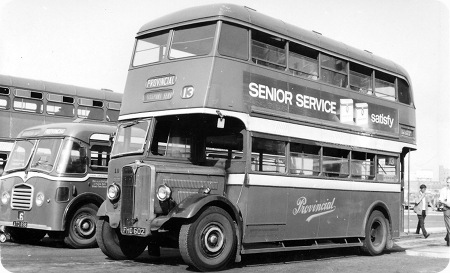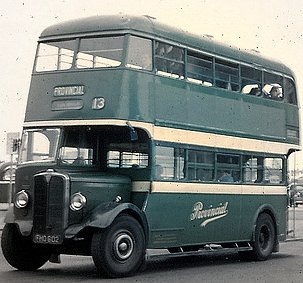Provincial – AEC Regent I – DAU 462 – 62

Photograph by ‘unknown’ if you took this photo please go to the copyright page.
Provincial (Gosport & Fareham Omnibus Co)
1937
AEC Regent I
Craven H56R
Here is another of the four ex Nottingham Regents that Provincial acquired in 1954 it was fleet number 220 in the Nottingham fleet. According to Stephen Didymus this vehicle was partially rebuilt during the late 1950s and ended up with a front destination layout to Provincial’s standard design of the time. Craven bodybuilders were located at Sheffield their main business appeared to be railway carriages but they also made tram and bus bodies. During the war they apparently made the wings for the "Horsa" troop carrying gliders, and components for the Lancaster bombers. They also built 120 AEC RT type vehicles for London Transport but they were not built to the same specification as the rest having five bay bodies instead of four is one example. Not being to the same specification also meant that their bodies would not be interchangeable with others RTs built by other bodybuilders so they did not last long with London Transport and were soon sold off.
Bus tickets issued by this operator can be viewed here.
———
Sheffield Transport’s 15 1948 Regent IIIs and the RTs were probably Cravens’ swansong before they concentrated on production of trams and then railway rolling stock – especially DMUs.
What isn’t widely known is that Cravens bought East Lancs in the early sixties, after a chance meeting of the chairmen of both companies. At the same time, they tried to expand by opening Neepsend Coachworks in that same district of Sheffield. Although Neepsend closed after only four years, both it and East Lancs were subsidiaries of Cravens – Neepsend was never owned by East Lancs. Cravens soon sold out to the bigger John Brown Group – a steel manufacturer in Sheffield – who eventually sold East Lancs on to Dawson Williams and Drawlane (which became British Bus and, eventually, Arriva).
David Oldfield
———
Nostalgic picture. I can recall the pre-war Regents working in Nottingham in the early 50s. 50 of this Cravens bodied version were supplied about 1938 (DAU451-500, running numbers 72-76 and 214-258). Metro-Cammell supplied a total of 93 (I think) during 1936-37, and Northern Counties 35 in 1935. From the sound, I would judge that they were all pre-selectors. I think that all varieties were originally built with narrow upstairs front windows flanking a central route number box, but most were subsequently rebuilt in the style shown on the photo. The Cravens had a slightly glowering appearance, and the Northern Counties had a more rounded dome and less steeply raked front. Internally, the three series were similar. Lighting was by naked bulbs in oval "volcano" fittings – except for the Northern Counties which had big circular "volcanos". The Cravens and MCs had plunger bells instead of "push once" buttons. Nearly all were displaced from front line service by the 1953-55 deliveries of Park Royal Regent IIIs (OTV127-198 with running numbers matching the registration). It was this that released various of them for sale to Provincial around 1954. Click here to see one in Nottingham about 1948.
Stephen Ford
Quick links to the - Comments Page - Contact Page - Home Page




